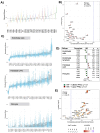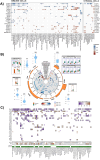Pan-cancer immune and stromal deconvolution predicts clinical outcomes and mutation profiles
- PMID: 40615649
- PMCID: PMC12227561
- DOI: 10.1038/s41598-025-09075-y
Pan-cancer immune and stromal deconvolution predicts clinical outcomes and mutation profiles
Abstract
Traditional gene expression deconvolution methods assess a limited number of cell types, therefore do not capture the full complexity of the tumor microenvironment (TME). Here, we integrate nine deconvolution tools to assess 79 TME cell types in 10,592 tumors across 33 different cancer types, creating the most comprehensive analysis of the TME. In total, we found 41 patterns of immune infiltration and stroma profiles, identifying heterogeneous yet unique TME portraits for each cancer and several new findings. Our findings indicate that leukocytes play a major role in distinguishing various tumor types, and that a shared immune-rich TME cluster predicts better survival in bladder cancer for luminal and basal squamous subtypes, as well as in melanoma for RAS-hotspot subtypes. Our detailed deconvolution and mutational correlation analyses uncover 35 therapeutic target and candidate response biomarkers hypotheses (including CASP8 and RAS pathway genes).
Keywords: Cell type estimation; Deconvolution; Immune cells; Integrated scores; Pan-cancer analysis; Somatic mutations; Stroma; Survival; Tumor microenvironment; Tumor progression; iScores.
© 2025. The Author(s).
Conflict of interest statement
Competing interests: The authors declare no competing interests.
Figures





References
-
- Hanahan, D. & Coussens, L. M. Accessories to the crime: functions of cells recruited to the tumor microenvironment. Cancer Cell21, 309–322 (2012). - PubMed
-
- Fridman, W. H., Pages, F., Sautes-Fridman, C. & Galon, J. The immune contexture in human tumours: impact on clinical outcome. Nat. Rev. Cancer12, 298–306 (2012). - PubMed
MeSH terms
Substances
Grants and funding
LinkOut - more resources
Full Text Sources
Medical
Miscellaneous

